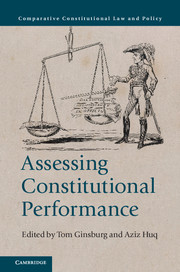Book contents
- Frontmatter
- Contents
- List of figures
- List of tables
- List of contributors
- Acknowledgments
- INTRODUCTION
- PART I DEFINING CONSTITUTIONAL PERFORMANCE
- 2 Hippocratic constitutional design
- 3 What is a good constitution? Assessing the constitutional proposal in the Icelandic experiment
- 4 When is a constitution doing well? The Alberdian test in the Americas
- 5 Parties and constitutional performance
- PART II MANAGING SPECIFIC CONSTITUTIONAL CHALLENGES
- PART III CASE STUDIES
- Index
- References
2 - Hippocratic constitutional design
from PART I - DEFINING CONSTITUTIONAL PERFORMANCE
Published online by Cambridge University Press: 05 August 2016
- Frontmatter
- Contents
- List of figures
- List of tables
- List of contributors
- Acknowledgments
- INTRODUCTION
- PART I DEFINING CONSTITUTIONAL PERFORMANCE
- 2 Hippocratic constitutional design
- 3 What is a good constitution? Assessing the constitutional proposal in the Icelandic experiment
- 4 When is a constitution doing well? The Alberdian test in the Americas
- 5 Parties and constitutional performance
- PART II MANAGING SPECIFIC CONSTITUTIONAL CHALLENGES
- PART III CASE STUDIES
- Index
- References
Summary
INTRODUCTION
Is there a criterion that can be used to evaluate constitutions written in Pretoria in 1996, Philadelphia in 1787, and Baghdad in 2005? Can the organic documents produced by democrats, oligarchs, tyrants, and theocracies all be judged by the same metric? This chapter, in taking up these questions, develops a benchmark for constitutional success with a general, albeit not universal, scope. That benchmark is independent of local criteria or prejudices, and relies instead on an analysis of the minimal conditions for constitutional success. Focusing my inquiry in that fashion, I contend that the most plausible touchstone of constitutional success is the avoidance of self-defeating constitutional design. It is a constitution purged of elements that conduce, perhaps unintentionally, to the breakdown or collapse of the state that the constitution endeavors to underwrite.
To situate this inquiry, it is useful to recall the dichotomy that Tom Ginsburg and I posit between metrics for evaluation of constitutional “success” that are internal and ones that are external in character. An internal criterion is one applied by a member of the polity engaged in constitutional creation or evaluation. An external criterion, by contrast, is one employed by an outsider such as a comparative constitutional scholar or a foreign advisor to constitutional drafters. So defined, the internal/external distinction turns on who applies the standard, not what the standard is. Human rights norms, for example, might be invoked both by participants to a drafting process as an internal criteria, or instead by transnational advocacy groups as a generally applicable external standard. Moreover, there is often leakage between internal and external criteria. Evaluative criteria deployed by participants in a constitution-making process are not autochthonic. They can leach their content and orientation from global intellectual currents (Ginsburg et al. 2008). Nor are external criteria necessarily loosed entirely from the gravitational force of the local circumstances of their intellectual production. Political rationality, in my view, lacks any transhistorical, acontextual form. Nevertheless, the distinction is useful insofar as it draws attention to the fact that criteria of constitutional success play different roles in different circumstances. And different standards might fit those distinct circumstances better than a single norm.
- Type
- Chapter
- Information
- Assessing Constitutional Performance , pp. 39 - 70Publisher: Cambridge University PressPrint publication year: 2016



